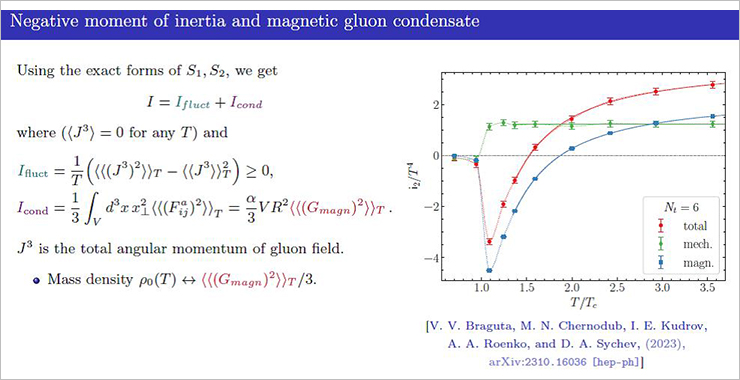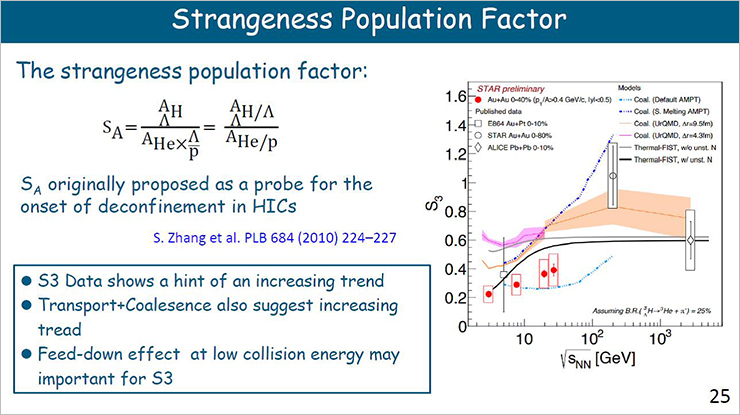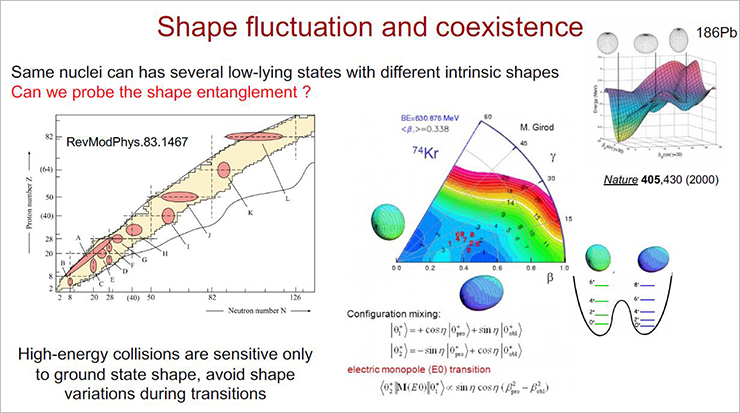International workshop on NICA data analysis and processing
News, 12 January 2024
On 25–27 December 2023, the international online workshop on methods of data analysis and processing in experiments at the NICA Accelerator Complex (NICA-2023) took place. The workshop was organized by the National Research Nuclear University MEPhI (NRNU MEPhI) and JINR and brought together over 100 scientists from Belarus, Bulgaria, China, India, Israel, Kazakhstan, Mexico, Russia, Serbia, Turkey, the USA, and Uzbekistan involved in the theory and analysis of real experimental data on the study of relativistic nucleus-nucleus collisions. In 2023, leaders of China’s groups in the MPD (Multi-Purpose Detector) International Collaboration at the NICA Accelerator Complex took an active part in organizing the workshop.
Most of the reports were devoted to discussing new results from the energy scan programme at the RHIC accelerator, which was completed within the STAR experiment in 2021. New results from the BM@N (Baryonic Matter at Nuclotron) Experiment and new research programmes for experiments under construction were also presented: MPD at the NICA Accelerator Complex and CEE (External-target Experiment at the Cooling Storage Ring) at the HIRFL accelerator complex (Lanzhou, China).
The issues discussed at the workshop included: the production of light nuclei and hypernuclei, production of strange particles; collective particle flows; vorticity of matter and its connection with the observed spin polarisation of hyperons and vector mesons etc.
Zhang Yapeng from the Institute of Modern Physics (Lanzhou, China) presented an overview of new results from the STAR collaboration on the formation of light nuclear clusters and hypernuclei in nucleus-nucleus collisions. It was noted that no theoretical model is able to simultaneously give satisfactory description of the rapidity distribution of light nuclei and their average transverse momentum. At the same time, the coalescence model makes it possible to quite successfully adjust individual characteristics of momentum distributions. It was shown that the statistical model describes the ratio of the number of protons to deuterons p/d well, but it overestimates the t/p and Λ3H/Λ ratios.
Zhu Xianglei from the Huzhou University (China) delivered the report on the systematics of the production of strange particles and showed new data from the STAR experiment on the production of ϕ-mesons. The ratios ϕ/K— and ϕ/Ξ— show a strong effect of canonical strangeness suppression.
An interesting question was raised in the report by Zebo Tang from the University of Science and Technology of China: which is the carrier of the proton baryon number, valence quarks or the nontrivial fusion of gluon fields binding the quarks? It is argued that the answer can be found in studying the correlations of net charges and net baryons in isospin collisions of the Ru+Ru and Zr+Zr mirror nuclei. Three experimental observations suggest that the baryon number is carried to a greater extent by the gluon configuration.
Several reports were devoted to the issues of cluster formation in collisions. Viktor Kireev (JINR) described how the cluster formation is implemented in the PHQMD transport model. Clusters are formed dynamically in it due to the potential interaction between nucleons and hyperons and are identified using the MST (Minimum Spanning Tree) model. For deuteron formation, a kinetic approach is used, involving the full isospin set of hadronic reactions, which enhances the formation of d.
An alternative approach to describing nuclear production as part of the combined UrQMD model and the statistical multifragmentation model (SMM) was presented by Nihal Buyukcizmeci from the Selcuk University (Turkey).
 Слайд из доклада Виктора Киреева
Слайд из доклада Виктора Киреева
The properties of quark-gluon matter under solid rotation can be studied in lattice QCD simulations. Artem Roenko (JINR) presented the results of such calculations at the workshop. It turns out that isothermic moment of inertia of plasma becomes negative in the temperature range above the critical temperature Tc, up to ~1.5Tc, and is positive at higher temperatures.
 Слайд из доклада Артема Роенко
Слайд из доклада Артема Роенко
Recently, the STAR and PHENIX collaborations presented preliminary results on direct photon interferometry in Au+Au collisions at √s = 200 GeV. These results were discussed in the report by Dmitry Peresunko (NRC KI). PHENIX demonstrated the consistency of the photon correlation function measured in the calorimeter and by the conversion method. The expected difference in d+Au and Au+Au collisions was also observed. The strength of the correlation measured at STAR turned out to be overestimated by 2 orders of magnitude. Probably, some background processes were not subtracted.
Petr Parfenov (NRNU MEPhI) reviewed the scaling properties of anisotropic flows at high baryon densities in his report. In particular, he compared the data obtained by the STAR collaboration at √s = 3 GeV and the HADES collaboration at √s = 2.4 GeV and noted the good consistency of the calculations within the JAM, UrQMD, and SMASH models with hard EOS with experimental data on proton flows. However, the models do not describe all types of particles equally well (in particular, meson flows, Λ, are described worse). He also demonstrated that scaling relations can be used to compare the results of the BM@N and MPD Experiments with existing experimental data and further constrain the models.
 Слайд из доклада Петра Парфенова
Слайд из доклада Петра Парфенова
The topic of anisotropic flows was also touched upon in the talk by Liu Zuowen from the Central China Normal University, who discussed new results from the STAR experiment for Au+Au collisions at energies of √s = 3–19.6 Gev. A negative direct flow is observed for ?+ and ? at low transverse momenta (pT < 0.6 GeV/c). This can be explained by the effect of interaction of particles with spectator nucleons. The NCQ scaling of elliptical flow, v2, is detected at collision energies of 14.6 GeV and above and breaks down at 3.2 GeV and below.
Wang Fuqiang from the Purdue University (USA) gave a report on the search for the chiral magnetic effect (CME) in relativistic collisions of heavy ions. The main task of the experimenters is to isolate the signal from the background of other processes. The background caused by collective particle flows is well studied and under control. The lack of flow is the next (and, the researchers hope, the last) problem. All indications suggest a terminal CME signal of ~10 %.
Sun Xu from the Institute of Modern Physics (Lanzhou, China) spoke about an interesting and as yet unexplained phenomenon: the polarisation of hyperons depends significantly less on the particle velocity than the polarisation of vector mesons.
Cao Shanshan from the Central China Normal University considered in the report the relation between the polarisation of hyperons and their direct flow.
Collective flows of hadrons were also discussed in the report by Sandeep Chatterjee from the Indian Institute of Science (IISER) in Bangalore, which particularly noted the role of energy density distribution at the initial moment of hydrodynamic expansion. The topic of flows and their fluctuations was touched upon in the report by Amaresh Jaiswal (IISER, India), which examined a boost-non-invariant blast-wave model.
The report by Jia Jiangyong from the Stony Brook University (USA) was devoted to attempts to study the shape of atomic nuclei in collisions of heavy ions. It was demonstrated that the deformation of colliding nuclei could significantly affect various harmonics of the collective flows of the produced particles.
Bronislav Zakharov (Landau Institute for Theoretical Physics) noted in his report that taking into account long-range correlations in nuclei is necessary to describe the ratio of elliptic and triangular flows (v2/v3).
Short-range nucleon-nucleon correlations are studied by the SRC experiment at the Nuclotron. The experimental results were presented by Or Heng from the Massachusetts Institute of Technology (USA).
Luo Xiaofeng from the Central China Normal University presented a review of the results of the STAR experiment on measurements of baryon fluctuations (kurtosis and higher moments of the baryon distribution) and correlations between strange and non-strange baryons.
Xiao Zhigang from the Tsinghua University (China) gave a status report on the planned external target experiment at CSR at the HIRFL facility in China. Victor Ryabov (Petersburg Nuclear Physics Institute, JINR) spoke about a new programme of experiments with a fixed target at the MPD facility, and Mikhail Kapishin (JINR) presented new data obtained by the BM@N Experiment on a xenon beam this year. Sergey Morozov (RAS Institute for Nuclear Research) presented in his report the concept of a new neutron detector for the BM@N Experiment.
At the end of each day of the workshop, specific time was allocated for additional discussion of reports. During the presentations, each participant could ask additional questions in the chat, which were collected by the workshop moderators into one document.
Most participants felt that the workshop was very successful and could well be considered the main international workshop related to the discussion of the physics of nucleus-nucleus collisions for the Nuclotron-NICA energy range out of those held in 2023 in Russia.








